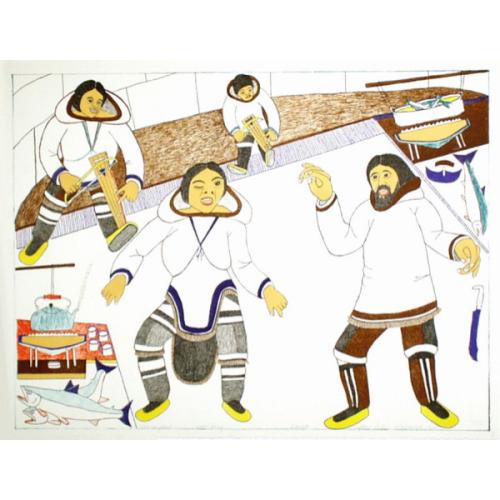
Peter Pitseolak
Canadian inuit, Kinngait, Cape Dorset, 1902 - 1973
Peter Pitseolak (Disc Number: E7-970)
1902 - 1973
Peter Pitseolak is very well known for his photography and is considered the first Inuk photographer. He also practiced in various mediums including drawing, watercolour painting, sculpting, and writing. Exemplifying his versatility as a creative, his works in the University of Lethbridge Art collection are drawings. Pitseolak was born on Tujjaat, living in traditional camps and relocating to Kinngait, Nunavut in the era of government settlement. He took his first photos in the 1930s and acquired his first camera in the years following, documenting the lives of Inuit in his community in thousands of images until his death in the 1970s. His motivation was to pass knowledge down to future generations, and his work is important particularly for the representation of Inuit through an Inuk lens. He often drew his photographs depicting Inuit lifestyles. James Houston, a qallunaaq (non-Inuk) who played an important role in the production and popularization of Inuit art in the south, knew Peter Pitseolak and called him “kind of a genius”. Peter Pitseolak’s photographs and graphic artworks have been in many exhibitions, including The World Around Me at the University of Lethbridge Art Gallery. There are two autobiographies on his life and work, People from Our Side (1975) and Peter Pitseolak’s Escape From Death (1977). The National Film Board produced a film on the artist in 1982 in Inuktitut, titled Peter Pitseolak: The Man Who Made Pictures. His photographic negatives were purchased by National Museums of Canada after his death, and his artwork is in many other institutions and galleries such as the Art Gallery of Ontario, the Glenbow Museum, the Inuit Cultural Institute, the McCord Museum, the McMichael Canadian Art Collection, the Winnipeg Art Gallery and others.
Interesting facts:
Peter Pitseolak School in Kinngait is named after the artist.
Peter Pitseolak designed and built an igloo out of foam bricks in the 1950s for an exhibition to show how igloos were made. An ill-conceived idea followed, suggested by non-Inuit government officials, that these could be used for temporary shelter.
1902 - 1973
Peter Pitseolak is very well known for his photography and is considered the first Inuk photographer. He also practiced in various mediums including drawing, watercolour painting, sculpting, and writing. Exemplifying his versatility as a creative, his works in the University of Lethbridge Art collection are drawings. Pitseolak was born on Tujjaat, living in traditional camps and relocating to Kinngait, Nunavut in the era of government settlement. He took his first photos in the 1930s and acquired his first camera in the years following, documenting the lives of Inuit in his community in thousands of images until his death in the 1970s. His motivation was to pass knowledge down to future generations, and his work is important particularly for the representation of Inuit through an Inuk lens. He often drew his photographs depicting Inuit lifestyles. James Houston, a qallunaaq (non-Inuk) who played an important role in the production and popularization of Inuit art in the south, knew Peter Pitseolak and called him “kind of a genius”. Peter Pitseolak’s photographs and graphic artworks have been in many exhibitions, including The World Around Me at the University of Lethbridge Art Gallery. There are two autobiographies on his life and work, People from Our Side (1975) and Peter Pitseolak’s Escape From Death (1977). The National Film Board produced a film on the artist in 1982 in Inuktitut, titled Peter Pitseolak: The Man Who Made Pictures. His photographic negatives were purchased by National Museums of Canada after his death, and his artwork is in many other institutions and galleries such as the Art Gallery of Ontario, the Glenbow Museum, the Inuit Cultural Institute, the McCord Museum, the McMichael Canadian Art Collection, the Winnipeg Art Gallery and others.
Interesting facts:
Peter Pitseolak School in Kinngait is named after the artist.
Peter Pitseolak designed and built an igloo out of foam bricks in the 1950s for an exhibition to show how igloos were made. An ill-conceived idea followed, suggested by non-Inuit government officials, that these could be used for temporary shelter.
